Pawpaw: America's Forgotten Fruit
Air Date: Week of August 26, 2016
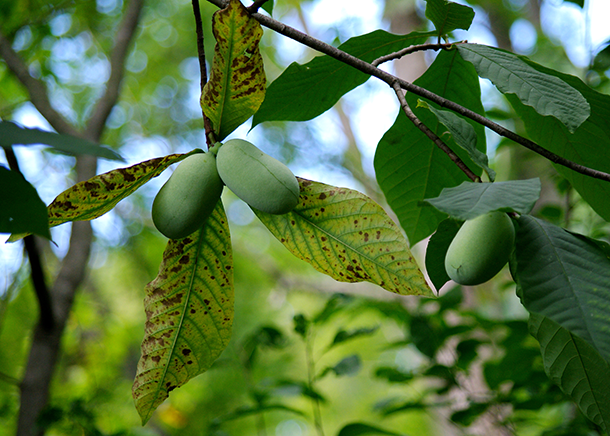
Pawpaws grow in clusters of one to six green fruit, which darken to a yellowish-black as they ripen. (Photo: Anna Hesser, Flickr CC BY-NC-ND 2.0)
The largest edible fruit native to the U.S. is unknown to most, yet the pawpaw has earned a loyal following among those who are familiar with it. A new book peers into the pawpaw’s storied past, how its popularity has grown today, and why it’s not a staple in the produce aisle. Writer Andrew Moore tells host Steve Curwood about his mission to find the human story in this forgotten fruit.
Transcript
CURWOOD: It's an encore edition of Living on Earth, I'm Steve Curwood. The largest edible fruit native to the United States was once a treat and a source of sustenance for Native Americans, presidents, and enslaved African Americans. Today it can still be freely foraged in the forests of twenty-six states. Chances are though, you’ve never tasted and only ever sung about the pawpaw. Andrew Moore explores the economic, biological and cultural reasons for our naiveté about this singular fruit in his book, Pawpaw: In Search of America’s Forgotten Fruit. He joins us now. Andrew, welcome to Living on Earth!
MOORE: Steve, thanks for having me.
CURWOOD: You've brought in your book, "Pawpaw: In Search of America’s Forgotten Fruit" and you've brought in a pawpaw.
MOORE: Yes, a pawpaw itself, and this is maybe one of the last pawpaws that I'll be lucky enough to get this year.
CURWOOD: Describe it for us would you please.
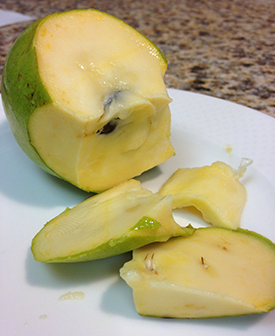
The taste of the pawpaw is usually described as a cross between a banana and a mango, but Moore says that subtler flavors like vanilla, caramel, and melon can also be discerned in the fruit, and its flesh varies in color from pale yellow to orange. (Photo: Mr.TinDC, Flickr CC BY-NC-ND 2.0)
MOORE: It kind of looks to me like a small mango. It's very green. Some other people describe it, it kind of looks like a russet potato.
CURWOOD: It is really fragrant.
MOORE: Really fragrant. The studio is really filled with the aroma now.
CURWOOD: I describe it as almost a mango aroma as well, so I've got to ask what it tastes like?
MOORE: Sure, so you mentioned mango already and a lot of people do describe it commonly it as a cross between a banana and a mango and what that's really getting at is that it has an unusual tropical flavor for an otherwise temperate fruit, and then the banana aspect gets at this creamy texture that the pawpaw has.
CURWOOD: Well, can I find out?
MOORE: Sure, yeah, do you want to cut into it?
CURWOOD: Yeah, OK, you go ahead. You're the expert cutter here.
[SOUNDS OF KNIFE ON PLATE AND CUTTING]
MOORE: The way I like to do it is to cut it in half, kind of like you might an avocado and twist it apart like a double stuffed Oreo and then when you do that you reveal essentially two cups of custard. The pulp as you can see is is this vibrant yellow, near orange in some places, and then you've also revealed a few rows of seeds down the center of the pawpaw and these are large black lima bean sized seeds that you can pick around or pull apart.
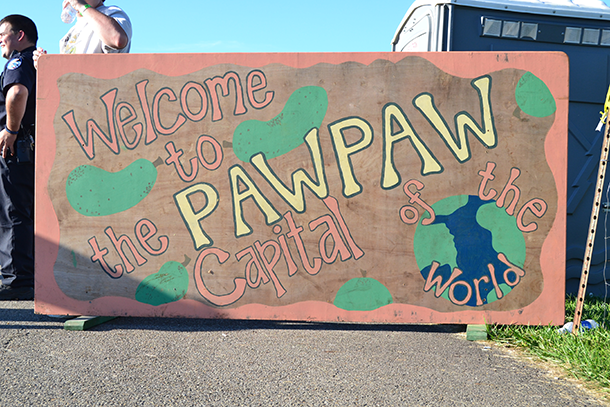
The Ohio Pawpaw Festival, which always takes place at the height of Ohio’s pawpaw season in September, drew a crowd of over 10,000 this year. (Photo: Andrew Moore)
CURWOOD: Now, I think it's been 20 or 30 years since I’ve tasted a pawpaw, so here it goes. Yum, that's really good.
MOORE: Does it taste like you remember?
CURWOOD: Yeah it tastes like it's got this slight little tangy edge to the banana, but it's mango, but no wait it's banana, no, wait it's mango and it's delicious. You know there are a lot of things one can do in life, Andy, why have you spent so much time researching, traveling around, paying attention to pawpaw? What drew you to the pawpaw?
MOORE: When I learned about it, first of all what happened was I was captivated. I was at the Ohio pawpaw festival and out in the woods, outside of the festival fairgrounds is a patch of wild pawpaws, and the experience of picking pawpaws from the trees, of picking them up from the ground, this wild bounty, this tropical tasting fruit that I had never heard of, that none of my family or most of my friends have never really heard of this thing, I was fascinated that something this good, this large, it's the largest edible fruit in the Native American woods, that it could be so unknown. And so I just wanted to learn more, so I just kept researching and looking online and I met the people who are working with pawpaws and I was certain that I wanted to write a story because I realize it had a really compelling human story as well.
CURWOOD: So you started on a pawpaw quest. What's it like to go pawpaw hunting?
MOORE: It's a lot of fun, and that was another reason why I set out writing the book. It was just --it was really fun to go to these places, whether it was wild patches on the banks of the Mississippi or whether it was Monticello in Mount Vernon or an experimental orchard where people were growing pawpaws and doing selective breeding. It was just a lot of fun to go to these places and meet these people.
CURWOOD: By the way, describe the pawpaw tree for me. What's it look like?
MOORE: Sure. Yeah, the pawpaw tree, and again it's confusing to me as to why it would be so unknown because the tree is beautiful as well. It has this lovely pyramidal shape when grown in full sun and it has these long tropical looking leaves. There are among the broadest and longest leaves you'll find in eastern forests and in fall they turn a striking yellow.
CURWOOD: And where can you find pawpaws?
MOORE: I often say that the pawpaw is a river fruit. It's native to 26 states in the eastern US and many of these rivers in these states are, in fact, lined with pawpaws in the deep alluvial rich soil and so that's a good place to start looking for them.
CURWOOD: So how come most of us have never heard of the pawpaw?
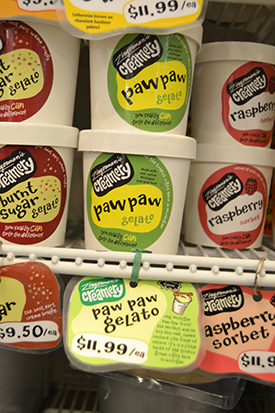
Pawpaw gelato is one of the more popular creations made from the fruit. (Photo: Andrew Moore)
MOORE: Right, well, I call it the forgotten fruit - that's in the subtitle - certainly some people have maintained memories of pawpaws, but for the most part we stopped knowing pawpaws when we stopped going to the woods for food. In the middle of the last century with the rise of supermarkets and global food and industrialized foods, our diets became a lot more homogenized and industrial and something that you would have to go to the woods to gather was left by the wayside. And pawpaw is not the only food certainly that we stopped eating and that we had neglected. There were so many heirloom fruits and vegetables - we had thousands of apples and old tomatoes. And so pawpaw is among those fruits that were lost, but that thankfully we're seeing a revival of.
CURWOOD: So, since it's free and available on the wild and such, what's your favorite survival story of somebody who needed the pawpaw to get over whatever challenge they were meeting?
MOORE: Well, among the early stories are Lewis and Clark subsisting on pawpaws at the end of their expedition along the Missouri River. They had completely run out of food and all they had was the wild bounty of pawpaws. Some people when they talk about it they'll say that the pawpaw saved them from hunger or they were near starvation, but in reality there were just so many pawpaws it was never a concern. They were all content and happy and just eating pawpaws for three days.
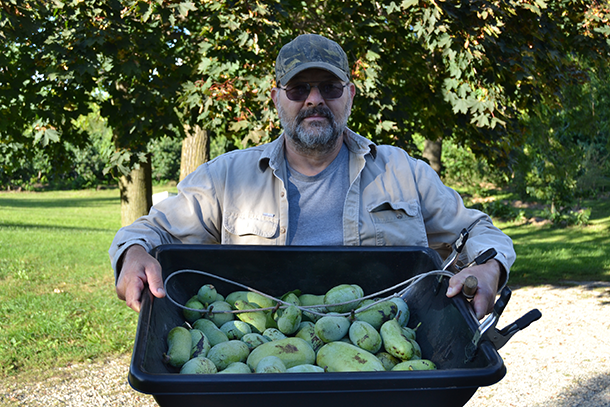
Marc Boone harvests pawpaws on his property in Michigan, at the northernmost extent of the pawpaw’s range. (Photo: Andrew Moore)
CURWOOD: So, historically, how did Native Americans use the pawpaw?
MOORE: Unfortunately there's not a lot of citations for Native American foodways before Europeans. There are some citations that survive that that we pawpaw people are thankful for. The Iroquois, for one, are cited as having dried pawpaws and cooked them into corncakes, which I found fascinating because corn is low in niacin and pawpaw is high in this nutrient. It's high in antioxidants and some of the same antioxidants that are found in red wine and chocolate. We also know that is high in various vitamins, vitamins A, C, potassium. These old folkways, they develop for a reason and there's a lot of wisdom in them.
CURWOOD: What's the relationship between the pawpaw and people of color?
MOORE: Enslaved African-Americans, they were looking to supplement diets if they had the liberty to pick things from the wild, pawpaw would've been one of those things that they could've gathered each year, as well on the Underground Railroad. Slaves seeking freedom in the north, pawpaw would have kept people alive as they were going north.
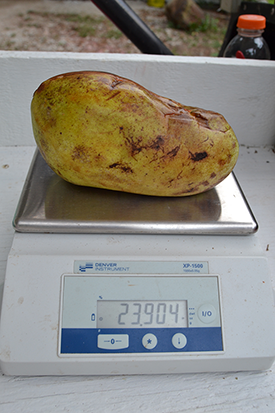
A pawpaw grown by Jerry Lehman weighs in at a whopping pound-and-a-half. (Photo: Andrew Moore)
CURWOOD: So, as you went on your odyssey around America looking for pawpaw, how many festivals did you get to?
MOORE: There were two prominent festivals that I went to when I was researching: the Ohio which is a large gathering now in its 17th year, around 8,000 people come out every year for that, and then in North Carolina which was newer at the time which is also growing. But now there's festivals in Rhode Island and Maryland, in New York, Pennsylvania...they're just popping up everywhere and so it's a really fun time for pawpaw people.
CURWOOD: And how do people who hunted and ate pawpaws a long time ago, say as kids, how do they react now when they taste their first pawpaw in decades?
MOORE: It's a really fun thing to share pawpaws with people who haven't had them in decades. They remember and they say, “oh, I used to love eating these as kids. We'd go on the river and pick them.” Or if they were coming home from school this was candy for them, they didn't have access to all these sweet foods like we do today, it was such a cherished treat, and it really seems like a personal fruit, everyone has these personal memories of gathering pawpaws, and that I think some of that has to do with the fact that as children, they did wander and gather these, but they were also shown this by loved ones, grandparents, or parents. It was like a family tradition to go and gather these things.
CURWOOD: The pawpaw place?
MOORE: Yes, the pawpaw place. The picking place.
CURWOOD: What are the various ways that people eat and I guess can even drink pawpaws these days, huh?
MOORE: Yeah, these days the skies the limit with what you can do with pawpaw and it's an interesting time. There's some great recipes out there but I think the best things that you can do with the pawpaw are products yet to be seen as people start experimenting with it. I make a pretty good pawpaw ice cream, pawpaw gelatos, sorbets, these are all very wonderful. Crème brûlée even and recently at the Ohio Festival, I tasted pawpawcello, so like a limoncello, a hard pawpaw lemonade and there were 11 pawpaw beers on hand. I didn't get a chance to drink all of them.
CURWOOD: That's right, I mean, good sweet fruit can lead to booze.
MOORE: Booze, absolutely and that's a tradition that goes as far back as the 17, 1800s. People in and around Pittsburgh and in the Ohio Valley down through Ohio were making pawpaw brandy and liquor and beer, and it's been known to be a strong alcohol even from those days on through today.
CURWOOD: Pawpaw kapow.
MOORE: [LAUGHS] Yeah, that's right.
CURWOOD: [LAUGHS] What are some of the challenges of cultivating and marketing pawpaws?
MOORE: Often it's said that the pawpaw's short shelf life and its fragility is why it has not been cultivated. That's a good starting place for talking about problems in domesticating the pawpaw. It is soft, and it does have a short shelf life, so it's not necessarily a fruit that lends itself well to sitting on the back of a truck and then going to distribution centers and then sitting on a supermarket shelf for several weeks. So it's just going to have a different niche. It's maybe not going to be something that is found in every Wal-Mart across the country, but it's more likely something that will be found at farmer's markets and local food co-ops.
CURWOOD: And perhaps on a menu of perhaps a local restaurant.
MOORE: Absolutely. We're seeing that more and more from New York to Missouri, chefs are adding it into their menus and doing wonderful things to it.
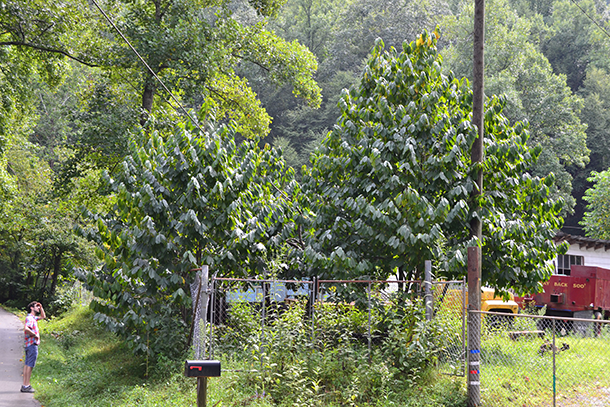
Author Andrew Moore found numerous pawpaw trees in easternmost Kentucky. (Photo: Andrew Moore)
CURWOOD: Now, at one point in your book you write about Neil Peterson working to improve pawpaw traits. Tell me his story.
MOORE: Sure, he's often described as a Johnny Pawpawseed kind of character. He was a graduate student at WVU and he tasted his first pawpaw along the banks of the Monongahela, and like myself and so many others, he was excited and eager to learn more, and as a plant scientist and a horticulturalist, Neal had the skills to try to do something with it, and so he set about doing a breeding experiment, and he started crossing the country himself seeking out old plantings and old cultivars from 50, 60 years ago when people had a greater interest in pawpaw and had started selecting pawpaws and naming them. So he planted two orchards with well over a thousand trees and after several decades selected the best pawpaws and released them to the public. Neal named his pawpaws after American rivers with Indian names in tribute to the original horticulturalists of the fruit - so Susquehanna, Shenandoah, Potomac - those are Neal's pawpaws and they're considered by many to be among the best that are available.
CURWOOD: Andy, could you please read from your book?
MOORE: I'd be happy to.
CURWOOD: Just describe for me with what's going on here when the search for the Ketter fruit.
MOORE: Yeah, in Ironton, Ohio I had been looking for the lost Ketter fruit. It was the prize-winning fruit from the 1916 contest for the best pawpaws in America, and I spent about three days searching for it.
[READING] In the morning, after a biscuit and fried apple breakfast, I decided to look for the trees planted by the uncle of my waitress at Jim's. Since the Ketter fruit has thus far eluded me it would be a boost in my sleuthing esteem to at least track down something. I find them, a massive pair, each 30 or 40 feet tall reaching above the power lines, and more or less right where she said they would be. Their leaves are deep green fading to yellow at the top of each pyramidal shape they've managed to make a Bradford pear or a black walnut look small in comparison. I stand in the grass taking photos when a neighbor calls out to me from her porch across the road. "Some people want to cut those trees down," she says. I ask why and who. "Just some neighbors on the block," she says. "They just want them gone. Don't want them anymore." I told her I don't see any sense in that. That they're good trees. "Tell me about it," she says. "I'm confused by all of it." But at least it offers some explanation as to why some things disappear - whims of the obstinate.
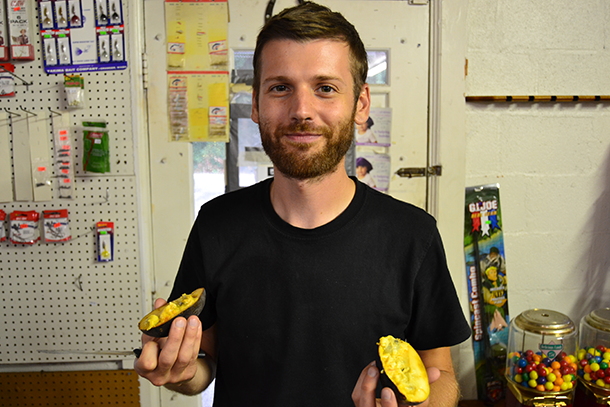
Andrew Moore is a writer and gardener who lives in Pittsburgh, Pennsylvania. (Photo: courtesy of Andrew Moore)
CURWOOD: How many of these do have in your backyard now?
MOORE: I have three trees in my backyard. It is a small backyard otherwise I might have more.
CURWOOD: [LAUGHS] And are they big enough to produce fruit yet?
MOORE: I'm hoping to get my first fruit next year actually. The flower buds have formed and I'll see them next spring and hopefully we get some fruit.
CURWOOD: So where oh where is little Andy?
MOORE: Way down yonder.
CURWOOD: In his pawpaw patch, huh? Andrew Moore is a writer and gardener living in Pittsburgh, Pennsylvania, just within the range of the pawpaw. "Pawpaw" is his first book. Andy, thanks so much for taking the time.
MOORE: Steve, thanks so much for talking to me.
Links
Pawpaw: In Search of America’s Forgotten Fruit
Living on Earth wants to hear from you!
Living on Earth
62 Calef Highway, Suite 212
Lee, NH 03861
Telephone: 617-287-4121
E-mail: comments@loe.org
Newsletter [Click here]
Donate to Living on Earth!
Living on Earth is an independent media program and relies entirely on contributions from listeners and institutions supporting public service. Please donate now to preserve an independent environmental voice.
NewsletterLiving on Earth offers a weekly delivery of the show's rundown to your mailbox. Sign up for our newsletter today!
 Sailors For The Sea: Be the change you want to sea.
Sailors For The Sea: Be the change you want to sea.
 The Grantham Foundation for the Protection of the Environment: Committed to protecting and improving the health of the global environment.
The Grantham Foundation for the Protection of the Environment: Committed to protecting and improving the health of the global environment.
 Contribute to Living on Earth and receive, as our gift to you, an archival print of one of Mark Seth Lender's extraordinary wildlife photographs. Follow the link to see Mark's current collection of photographs.
Contribute to Living on Earth and receive, as our gift to you, an archival print of one of Mark Seth Lender's extraordinary wildlife photographs. Follow the link to see Mark's current collection of photographs.
 Buy a signed copy of Mark Seth Lender's book Smeagull the Seagull & support Living on Earth
Buy a signed copy of Mark Seth Lender's book Smeagull the Seagull & support Living on Earth

